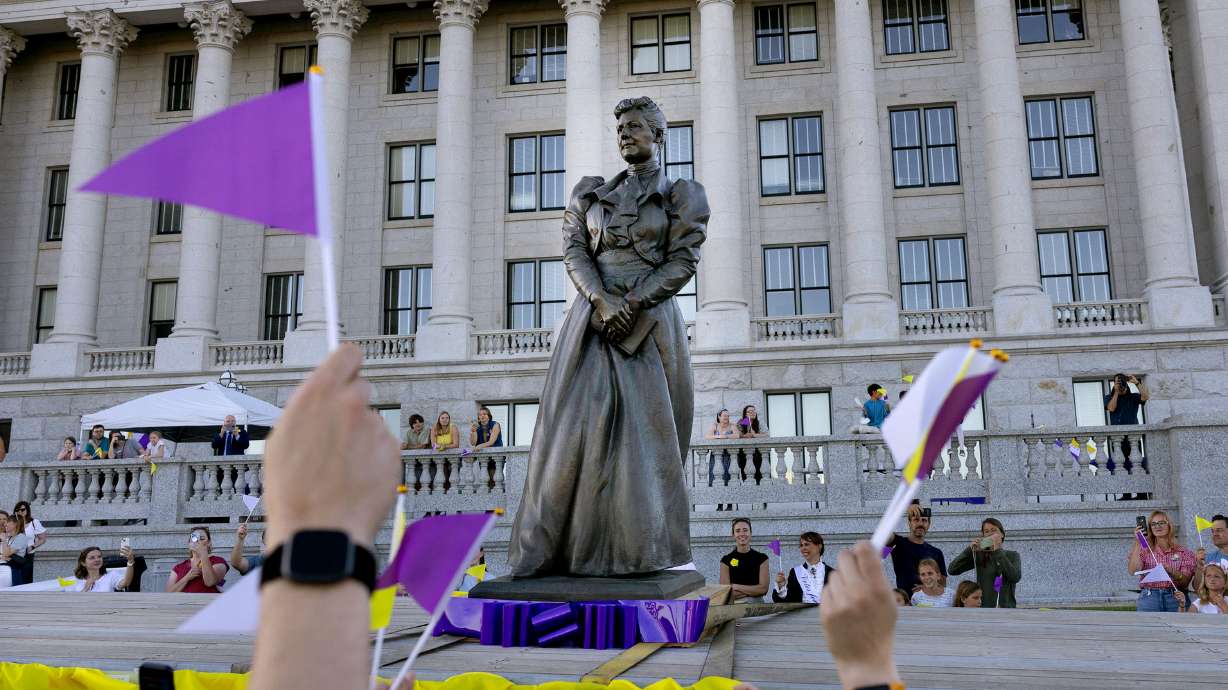Estimated read time: 5-6 minutes
This archived news story is available only for your personal, non-commercial use. Information in the story may be outdated or superseded by additional information. Reading or replaying the story in its archived form does not constitute a republication of the story.
SALT LAKE CITY — Scores of people lined a pathway, waving violet, gold and white flags — colors representing women's suffrage — and chanting "Martha!" as a semitruck slowly carried a statue depicting Utah legislator, doctor and suffragist Martha Hughes Cannon away from the steps of the Utah Capitol.
This was the first leg of a 2,000-mile journey the statue will now make to Washington, D.C., before the statue reaches its permanent home at the National Statuary Hall inside the U.S. Capitol later this year.
This enthusiastic sendoff was multiple years in the making, and Lt. Gov. Deidre Henderson, who played a role in getting the statue created, said she believes the fanfare over the statue goes beyond what Cannon accomplished in life.
"She symbolizes even more than that. She symbolizes what our state and our people did for America," she said moments before the statue was hauled off. "You can't talk about the history of suffrage in the United States without talking about Utah."
The story of the statue goes back to 2018, when Utah legislators approved a bill that set up the Martha Hughes Cannon Statue Oversight Committee that Henderson — then a state senator — ultimately co-chaired. The committee oversaw efforts to design a statue and send it to Washington.
The 7-foot-6, 550-pound statue designed by artist Ben Hammond was first unveiled at the Utah Capitol in 2020, the same year it was supposed to be installed at National Statuary Hall.
However, a pandemic got in the way. Henderson said supply chain shortages made it difficult to acquire the pedestal on which the statue would be placed. The U.S. Capitol was closed to visitors for multiple years over COVID-19 concerns on top of that. It only reopened to visitors last year.
And that was just the beginning.
"There were a lot of approval processes to go through with the architect of the Capitol, and we had several different speakers of the House during that time — there was just a big process, and it took a while," she explained.

But those who championed the statue say Wednesday's farewell was well worth the wait because they believe Cannon's story deserves to be told to a national audience.
"Dr. Cannon was exceptional in some ways, but she's really representative of folks who have made Utah their home," said Katherine Kitterman, executive director of Better Days, an organization that highlights women's history in Utah and helped champion the statue.
Who was Martha Hughes Cannon?
Martha "Mattie" Hughes was born in Wales in 1857. Her family immigrated to the U.S. when she was 3 years old and quickly moved to Utah after joining The Church of Jesus Christ of Latter-day Saints. While in America, she endured the deaths of her father and young sister, which inspired her to become a doctor, according to a biography compiled by Rebekah Clark for Better Days in 2018.
She studied at what is now the University of Utah before earning medical and pharmaceutical degrees at the University of Michigan and the University of Pennsylvania, respectively. Clark pointed out that Hughes was the only woman in her class at the time.

Hughes set up a private practice and became a resident physician at Deseret Hospital when she returned to Utah, as she followed her large ambitions.
After marrying Angus M. Cannon in 1884, Martha Hughes Cannon — who had first joined Utah's women's rights movement while in college — went on to oversee the Utah Women's Suffrage Association and served as a key speaker at national events. Then, as Utah gained statehood in 1896, Cannon successfully ran a campaign to serve as a state senator, defeating her husband, among others, in the race.
As the first woman elected to a state senate in U.S. history, Cannon led several notable laws including the bill that set up the Utah State Board of Health — the precursor to what's now the Utah Department of Health and Human Services. Clark noted Wednesday that Cannon also pushed heavily for a national suffrage law and passed legislation that expanded education in Utah.
Honoring Cannon's legacy
Cannon eventually moved to California for health reasons after her time in the Legislature. She died in 1932 at the age of 75 and was buried at the Salt Lake City Cemetery.
"Martha dared to dream big, and the good that she did in her life continues to inspire us today," Clark said, summing up Cannon's life on Wednesday.
Martha is officially off to Washington. The crowd chants "Martha" and she's hauled off from the Utah Capitol pic.twitter.com/MqQHmZ6Cbh
— Carter Williams (@cwilliamsKSL) June 6, 2024
And she, Henderson and others believe the statue matters because of issues that still exist today.
There's still a major gap of women in politics long after Cannon; Henderson pointed out that she only became the 27th woman elected to Utah's Senate in 2013 — 116 years after Cannon became the first. The statue will also be one of only the 14 women out of 100 people honored at the U.S. Capitol.
"Sending Martha to Washington to represent our state sends a message of who and what we value," Kitterman said, adding that she believes it can inspire children to become leaders like Cannon.
Henderson said she cherishes the inspiration she felt over the past four years as she walked past the Cannon statue at the Utah Capitol. She now hopes that others will feel the same at the nation's capital.
"I'm kind of sad — in a way — to see her sent off to Washington, but that's where she belongs," she said. "I'm excited that this day has finally come."









